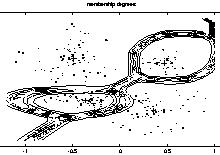Information Engineering Lab

Information Engineering LabF. Höppner, Ostfalia University of Applied Sciences
|
 |

Cluster analysis divides data into groups (clusters) such that similar data objects belong to the same cluster and dissimilar data objects to different clusters. The resulting data partition improves data understanding and reveals its internal structure. Partitional clustering algorithms divide up a data set into clusters or classes, where similar data objects are assigned to the same cluster whereas dissimilar data objects should belong to different clusters. In real applications there is very often no sharp boundary between clusters so that fuzzy clustering is often better suited for the data. Membership degrees between zero and one are used in fuzzy clustering instead of crisp assigments of the data to clusters. The most prominent fuzzy clustering algorithm is the fuzzy c-means, a fuzzification of k-Means or ISODATA.
Areas of application of fuzzy cluster analysis include for example data analysis, pattern recognition, and image segmentation. The detection of special geometrical shapes like circles and ellipses can be achieved by so-called shell clustering algorithms. Fuzzy clustering belongs to the group of soft computing techniques (which include neural nets, fuzzy systems, and genetic algorithms).
The family of objective function-based fuzzy clustering algorithms includes, amongst others, the ...
You can find some publications related to fuzzy clustering below, a few of them are available on-line (g'zipped postscript (.ps.gz) and portable document format (.pdf)).